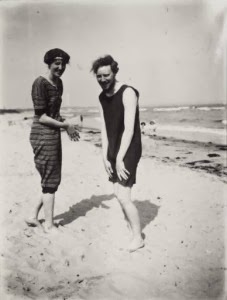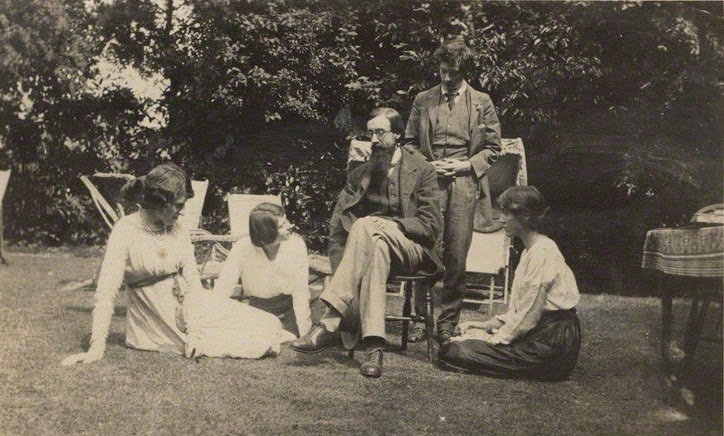 |
| Virginia Woolf & Clive Bell 1909 |
Found in a Times Literary Supplement from 1954 this anonymous review of J.K. Johnstone's The Bloomsbury Group. Clive Bell did not agree with much of the information or opinions in this article and wrote a letter to the editor in response, which appeared a week later. Oddly he wrote later that the review "is by far the most intelligent and penetrating piece that has been written on the subject." It is obviously by someone very familiar with the group. The Bloomsbury industry did not start in earnest until 1967, the year of love, with Michael Holroyd's monumental biography of Lytton Strachey. Interesting to note that Maynard Keynes was very slightly looked down on by the set - possibly this is something Bell addresses in his letter.
THE AIR OF BLOOMSBURY
Mr. Johstone's The Bloomsbury Group is a respect-worthy book. lt often shows imaginative insight, and always long and sincere thought. Sometimes we detect a faint aroma of what Mr. Forster calls pseudo-scholarship, but this might well have been far stronger and more frequent, considering that his study of the Bloomsbury Group, as he calls it, was first conceived as a Ph.D. thesis. A pseudo-scholar, Mr. Forster explain (adding endearingly that this is what most of us are) is one who moves around books and not through them. “Books have to be read," he adds, characteristically,"worse luck for it takes a long time; a few savage tribes eat them, but reading is the only method of assimilation revealed lo the west. The reader must sit down alone and struggle with the writer. . . ." And this Mr. John- stone has done faithfully and well, almost throughout. His book is mainly a study of the three Bloomsbury writers, Lytton Strachey, the biographer, and the two novelists, Virginia Woolf and Mr. E. M. Forster... [the reader]will surely find that Mr.J increases his insight into their art, and their unobtrusive mastery of pattern and design. Indeed Virginia Woolf, he shows, invented almost a new novel form to express her "experience of living,"...
Mr. Johnstone's book has one main thesis. He sets out to show that the members of the Bloomsbury Group had common values stemming from an original gospel, the early Cambridge philosophy of G. E. Moore formulated in his
He writes of their "pursuit of truth with absolute devotion…" and of how,in his Victorian idiom, they indulged in "playful banter." "Yet each respects the other," he says,“ and when he discourses tries to learn from him, and see what he sees"; thus he links the apostles with the disciples of Plato, and rightly so, as any reader of (Goldsworthy) Lowes Dickinson's A Modern Symposium may see for himself.
From Moore`s philosophy sprang Bloomsbury`s common aesthetic...chiefly formulated by that brilliantly perceptive art critic, Roger Fry. lt was also ably developed and expounded by the inventor of the now classic phrase "significant form" Mr. Clive Bell, “that gay and amiable dog," as Maynard Keynes was afterwards to call him, in the spirit of Sidgwick's "playful banter." It ought indeed lo be more evident through Mr.Johnstone's grave reconstruction of the Group, how much time its members spent laughing at one another,and also, most unlike Victorian apostles,how outrageously ribald they could be on occasion.
But along comes Mr. Clive Bell,one of the original 'Blooms-
berries' (for so, he says, Mrs. Desmond MacCarthy first
nicknamed and spelt them) to tell us that they cannot
usefully be called a group at all. Certainly he admits that
there originated in Cambridge in 1904 a close circle having
as its main (spokesmen) Lytton Strachey, Moore and Maynard Keynes, & including among others Thoby,the eldest son of Leslie Stephen, and himself. He agrees that later,after Thoby Slephen`s early death, the circle re-formed round the two houses, both in Bloomsbury,of Thoby's sisters,Vanessa Bell & Virginia Woolf. He agrees, too, that it was widened by the acquisition of the rather older Roger Fry (this addition was obviously of crucial importance to the Group) and again by Mr. E. M. Forster. Though Mr.Forster Mr. Bell points out, did not live in London and while he became a most valued friend,was never entirely one of them. Mr. Bell is also anxious to make clear that Keynes, for all his brilliance and growing achievements in the great outside world, did not carry so much weight in the Bloomsbury one. He was comparatively lacking in (first-hand) sensibility; he was not a creative artist in fact, and how low that society, so alarmingly exclusive, rated action of any kind! Even action in a novel, at least in the form of 'a story, was suspect:-“Neanderthal man listened to stories," writes Mr. Forster, “if one may judge from the shape of his skull."
[A few passages left out, as slightly redundant and also for copyright reasons...a long article, more to come when time allows.]


Thanks for putting this up. I think fascination with the Bloomsberries began a little earlier with David Garnett's autobiography -The Golden Echo; The Flowers of the Forest; The Familiar Faces published between 1953 and 1962. That's what got me interested anyway.